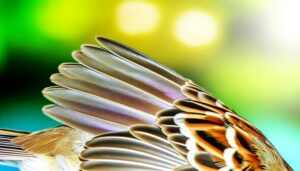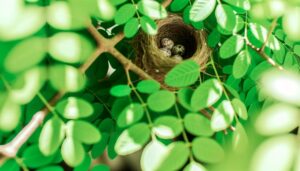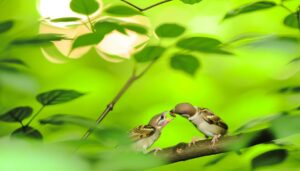How Long Does a Sparrow Egg Take to Hatch?
Sparrow eggs typically hatch within 10 to 14 days, given best incubation conditions, which include maintaining a temperature range of 37.5°C to 38°C. Female sparrows primarily undertake the incubation process while males contribute by providing support and protection.
Factors influencing hatching success include humidity, ventilation, and nest location. Parental care and environmental conditions greatly impact the viability and development of the eggs.
Understanding the incubation period and developmental stages is essential for comprehending sparrow reproductive strategies. Learn about the intricate processes and environmental requirements that contribute to successful hatching.
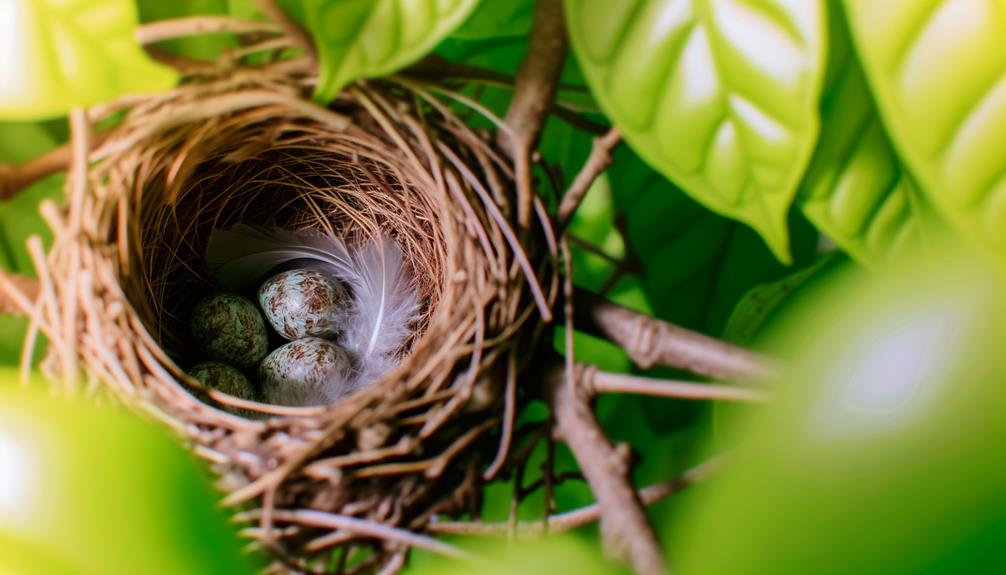
Key Takeaways
- Sparrow eggs typically hatch after an incubation period of 10 to 14 days.
- The female sparrow primarily incubates the eggs, ensuring optimal temperature and conditions.
- Ideal incubation temperatures range from 37.5°C to 38°C.
- Proper humidity and ventilation are crucial during the incubation period.
- Environmental factors like nest location can affect the exact hatching time.
Sparrow Breeding Season
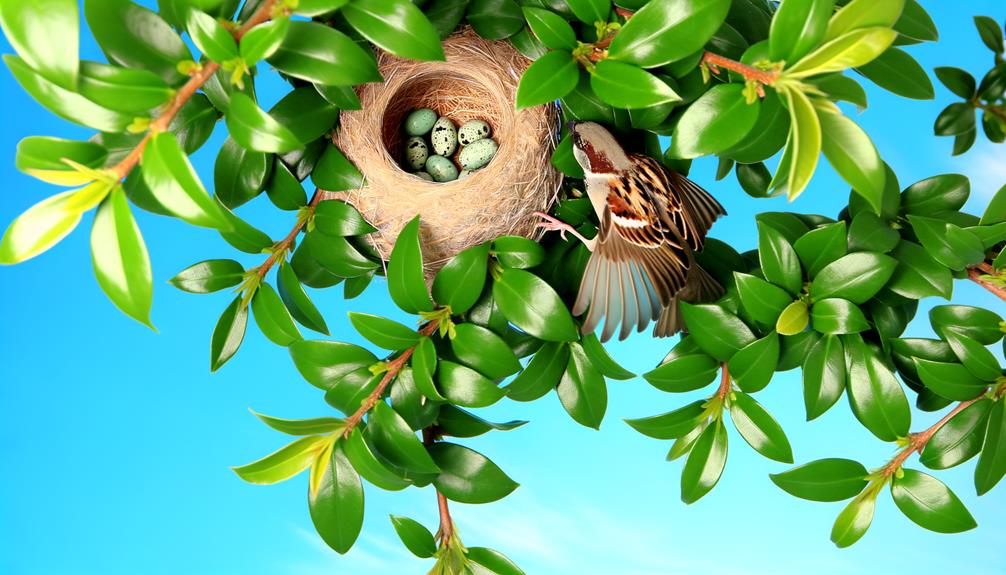
Although environmental factors can influence variations, the sparrow breeding season typically commences in the early spring and extends through late summer. During this period, sparrows engage in a series of behaviors aimed at successful reproduction.
Males establish and defend territories through vocalizations and physical displays, which are vital for attracting mates. Females select mates based on these displays, leading to pair formation. Once paired, sparrows engage in courtship rituals that include feeding and mutual preening.
The breeding season's timing ensures that offspring have access to abundant food resources, an essential factor for chick survival. This period also aligns with ideal weather conditions, facilitating the growth and development of young sparrows. Therefore, the breeding season is a crucial phase in the sparrow's life cycle.
Nesting Habits
Following pair formation during the breeding season, sparrows exhibit specific nesting habits that are crucial to the reproductive process. Typically, sparrows select nesting sites within cavities or crevices in urban and rural environments. These sites can include tree holes, building eaves, or nest boxes.
Both male and female sparrows participate in nest construction, using materials such as grass, feathers, and paper. The nest is meticulously crafted to provide insulation and protection for the eggs. The inner cup of the nest is particularly important, as it guarantees a stable microenvironment necessary for egg incubation.
Nesting behavior and site selection are crucial for reproductive success, influencing factors such as predation risk and microclimate stability, thereby directly impacting the hatching success rate.
Egg Characteristics
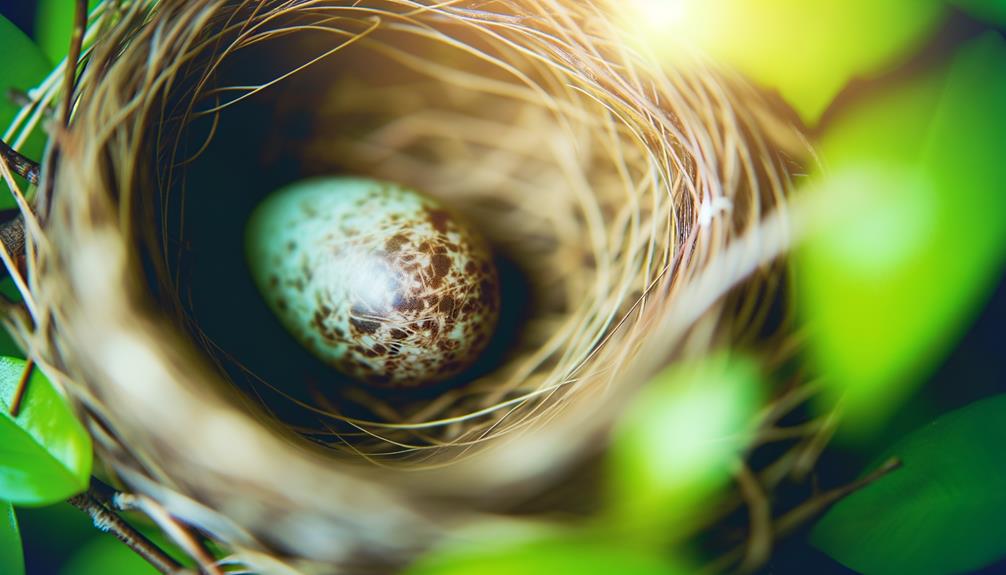
Egg characteristics play a vital role in the successful hatching of sparrow eggs. Specifically, these characteristics include size and coloration, shell texture, and incubation conditions.
Sparrow eggs typically measure around 1.5 to 2 centimeters in length and exhibit a speckled appearance that aids in camouflage. The texture of the eggshell, combined with the best temperature and humidity levels during incubation, greatly influences embryonic development and hatchling viability.
Size and Coloration
Sparrow eggs typically measure around 2 centimeters in length and display a variety of colors, ranging from white to pale blue, often speckled with brown or gray markings. These color variations serve as a form of camouflage, helping to protect the eggs from predators by blending into the natural surroundings of the nest.
The speckling patterns are not uniform and can vary significantly between individual eggs, even within the same clutch. This variability in coloration and patterning may be influenced by genetic factors as well as environmental conditions.
Understanding these characteristics is essential for ornithologists and researchers who study avian reproduction and ecology, as it provides insights into the adaptive strategies employed by sparrows to enhance reproductive success.
Shell Texture
Interestingly, the texture of sparrow eggshells can provide significant information about their structural integrity and the environmental conditions during formation. The surface of sparrow eggs is typically smooth, but subtle variations can occur. These variations might include minor roughness or tiny pores which are essential for the exchange of gases, allowing the developing embryo to breathe.
Additionally, the thickness and rigidity of the shell are indicators of calcium availability in the female sparrow's diet. A well-formed shell with uniform texture suggests ideal conditions, whereas irregularities might signal nutritional deficiencies or environmental stressors. Understanding these characteristics aids in evaluating the viability and successful hatching of the eggs, thereby offering insights into the reproductive health of sparrows.
Incubation Conditions
Ideal incubation conditions are crucial for the successful development and hatching of sparrow eggs, directly influencing embryonic growth and overall egg characteristics. Key parameters include temperature, humidity, and ventilation.
Temperature:
The best temperature range for sparrow egg incubation is between 37.5°C to 38°C. Deviations can cause developmental abnormalities or embryonic mortality.
Humidity:
Maintaining a relative humidity of approximately 50-55% is essential. Insufficient humidity can lead to excessive water loss, while excess humidity can impair gas exchange.
Ventilation:
Adequate airflow ensures proper oxygen supply and carbon dioxide removal. Insufficient ventilation can result in hypoxia, adversely affecting embryonic respiration.
These conditions collectively promote the viability and health of the developing embryo, thereby optimizing hatching success rates.
Incubation Period
The incubation period for sparrow eggs is crucially influenced by the ideal temperature range, typically maintained between 37.5°C and 38.5°C.
Both male and female sparrows contribute to the incubation process, although the female generally assumes a more significant role.
Understanding these factors is essential for comprehending the conditions necessary for successful hatching.
Optimal Temperature Range
Determining the best temperature range for sparrow egg incubation is important for guaranteeing successful hatching and the development of healthy chicks. Research indicates that the best temperature range for incubating sparrow eggs is between 37.5°C and 38.0°C. Deviations from this range can negatively affect embryonic development and hatch rates.
Several factors contribute to maintaining this ideal temperature:
- Consistent Heat Source: Utilizing a reliable incubator or brooding parent ensures a stable temperature.
- Thermal Regulation: Proper insulation and ventilation systems help maintain the desired temperature while preventing overheating.
- Regular Monitoring: Employing thermometers or digital sensors to frequently check and adjust the temperature is essential.
Maintaining these conditions optimizes embryo development and enhances the likelihood of successful hatching.
Parental Roles
In addition to maintaining best temperature, understanding the roles of sparrow parents during the incubation period is essential for successful hatching.
Typically, the female sparrow undertakes the primary responsibility for incubating the eggs, guaranteeing they are kept at an ideal temperature of approximately 37.5°C.
The male sparrow, while not directly incubating, plays a pivotal supportive role by providing food and protecting the nesting site from potential predators. This division of parental duties ensures that the eggs receive consistent warmth and the female remains nourished.
The incubation period generally lasts 11-14 days, during which the female intermittently adjusts the eggs to promote uniform development. Such coordinated parental efforts are necessary for maximizing the probability of successful hatching.
Role of Both Parents
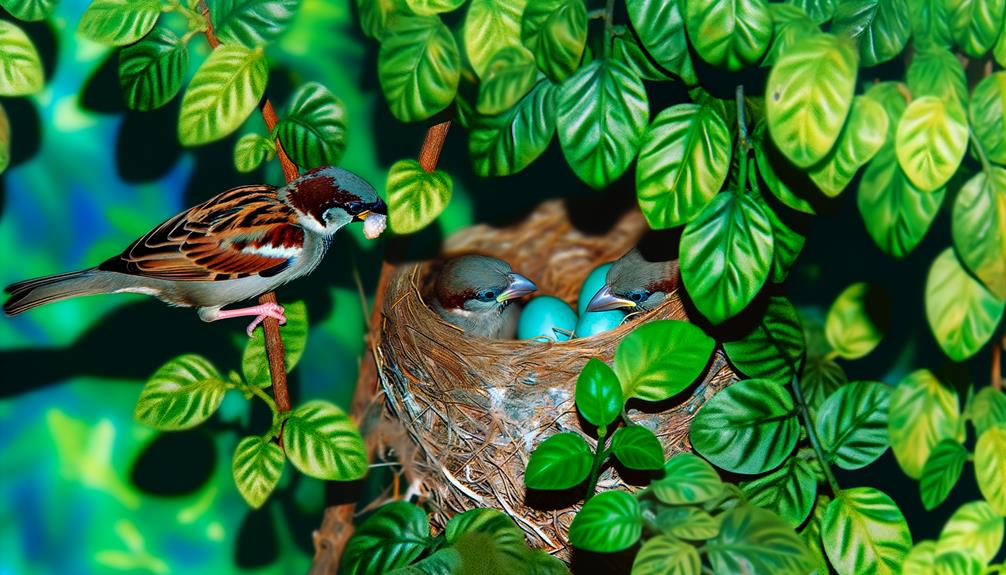
Parental collaboration plays a crucial role in the successful incubation and hatching of sparrow eggs. Both male and female sparrows engage in activities essential for the development of the eggs. The division of labor between parents guarantees that the eggs receive optimal attention.
Key parental roles include:
- Incubation: Both parents take turns sitting on the eggs to maintain the necessary temperature for embryonic development.
- Feeding: The male often provides food for the female during incubation, ensuring she remains nourished and can continue her duties without frequent foraging breaks.
- Nest Protection: Both parents guard the nest from potential predators and environmental threats, increasing the likelihood of successful hatching.
This collaboration maximizes reproductive success and guarantees the survival of their offspring.
Environmental Factors
While parental cooperation is essential, the environmental conditions surrounding the nest also impact the hatching success of sparrow eggs. Factors such as temperature, humidity, and nest location play significant roles in determining the incubation period and overall egg viability.
| Factor | Best Range | Impact on Hatching |
|---|---|---|
| Temperature | 37°C-38°C | Critical for embryo development |
| Humidity | 50%-60% | Prevents dehydration or overhydration |
| Nest Location | Sheltered, predator-free | Reduces risk of predation and exposure |
Maintaining an appropriate temperature is crucial for enzymatic activities within the egg. Humidity levels must be balanced to guarantee proper gas exchange and moisture retention. Nest location affects the microclimate and protection against predators, thereby indirectly influencing the incubation period and hatching success.
Egg Viability
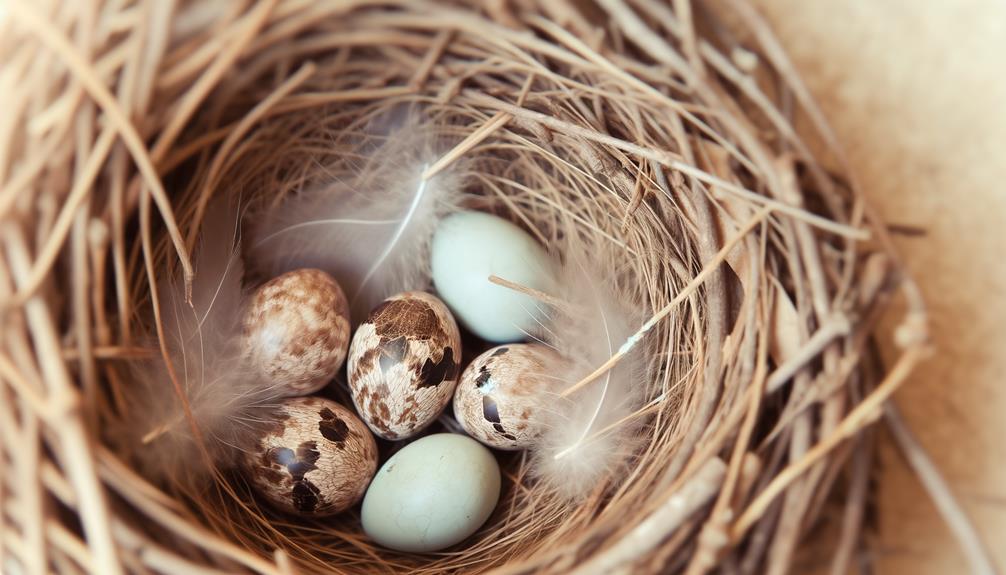
Evaluating egg viability involves considering the inherent and external factors that influence the potential for successful hatching. Inherent factors are intrinsic characteristics of the egg itself, including genetic quality and membrane integrity.
External factors encompass the environmental conditions surrounding the egg, such as temperature, humidity, and parental care.
Key considerations include:
- Genetic Quality: The genetic health of the parent sparrows and the absence of genetic defects are pivotal.
- Environmental Conditions: Optimum temperature and humidity levels are necessary to maintain the egg's viability.
- Parental Behavior: Proper incubation behavior by the parent sparrows, including consistent warmth and minimal disruptions, significantly affects hatching success.
Understanding these factors provides vital insights into the conditions facilitating successful hatching of sparrow eggs.
Stages of Development
The stages of development in sparrow eggs encompass a series of meticulously timed embryonic processes that culminate in hatching. Initially, the fertilized egg undergoes cleavage, where rapid cell division forms a blastoderm. This blastoderm gradually differentiates into the embryo and extra-embryonic structures.
By day three, the formation of the neural tube and somites marks early organogenesis. By mid-incubation, critical structures such as the heart and circulatory system are functional. Limb buds appear, and feather germ development commences.
The final days of incubation involve significant growth and refinement of organs, including the respiratory and digestive systems. This precise orchestration of cellular differentiation and growth ensures the embryo is fully prepared for the shift from egg to independent chick.
Hatching Process
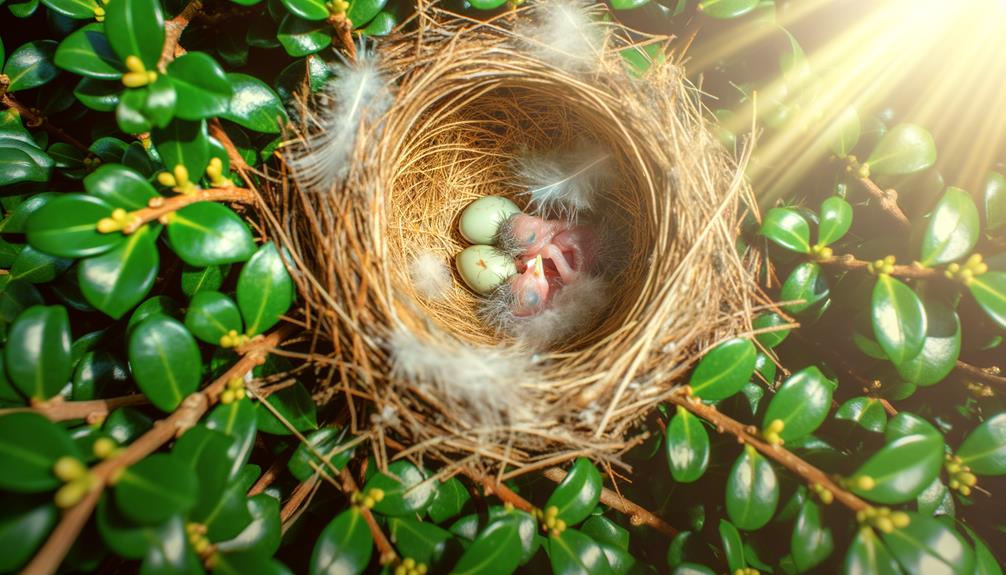
As the incubation period concludes, the chick initiates the hatching process by piercing the inner shell membrane using its egg tooth. This specialized structure, located on the tip of the beak, is essential for breaking through the eggshell.
The hatching process can be divided into three distinct stages:
- Pipping: The chick creates a small hole in the eggshell to start the breathing process.
- Rotation: The chick gradually rotates within the egg, enlarging the initial hole by chipping away at the shell.
- Emergence: Finally, the chick pushes itself out of the shell, completing the hatching process.
Each stage is crucial for ensuring the chick's successful entry into the external environment, where it will continue its development.
Post-Hatching Care
After emerging from the shell, the newly hatched sparrow chick requires immediate and continuous care to guarantee its survival and proper development. The parents engage in meticulous feeding, providing a diet rich in protein such as insects and worms, which is essential for rapid growth.
The nestlings are fed every 15 to 20 minutes during daylight hours. Thermoregulation is another vital aspect; the chicks are brooded by the parents to maintain ideal body temperature. Moreover, the nest must be kept clean, as the parents remove fecal sacs to prevent disease.
This intensive care continues until fledging, typically around 14 days post-hatching, when the chicks are sufficiently developed to leave the nest and begin independent life.
Conclusion
The incubation of sparrow eggs unfolds like a delicate, orchestrated ballet, where each stage is meticulously timed and executed.
Nestled within the carefully constructed nest, the eggs undergo a transformation over approximately 10 to 14 days. Both parents, acting as diligent guardians, provide the best conditions for their offspring's development.
Upon hatching, the fragile chicks emerge, initiating a new cycle of life. This process exemplifies nature's intricate design and the resilience of avian life.


